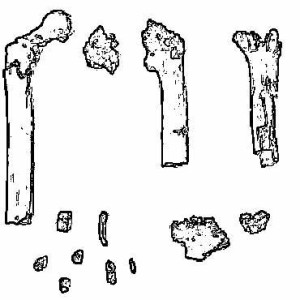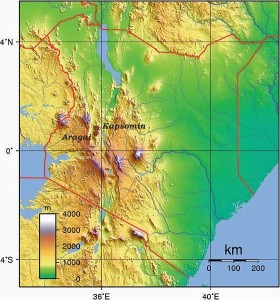Part II: Miocene Epoch
7. Orrorin tugenensis
Orrorin tugenensis (~6 mya)
(“original” / Tugen hills)

SITES
Aragai and Kapsomin in the Tugen Hills of Kenya
PEOPLE
Brigitte Senut and Martin Pickford
INTRODUCTION
In 2000, the team of Brigitte Senut and Martin Pickford discovered fossil material (see Figure 7.1) from the Lukeino Formation in the Tugen Hills of Kenya. Nicknamed “Millenium Man” due to its timely discovery, the fossils were dated to ~6 mya and given the taxonomic classification, Orrorin tugenensis (“original man from the Tugen hills”). Initially many paleoanthropologists were skeptical, especially since the fossils were not made available to the scientific community. While there is still debate, O. tugenensis is increasingly presented in published texts as a hominin.
PHYLOGENY
The ancestry of O. tugenensis is unknown. Senut and Pickford believe that Orrorin is ancestral to humans. They suggest that the hominin tribe split prior to 6 mya with Orrorin and some species of australopiths (specifically Australopithecus anamensis and Australopithecus afarensis, which they place in the genus Preanthropus) in the human lineage and ardipiths and robust australopiths, or paranthropines (including Australopithecus africanus), on another branch that died out.
DISCOVERY AND GEOGRAPHIC RANGE
There are only two known sites for the species, Aragai and Kapsomin, both of which are in the Tugen Hills of Kenya (see Figure 7.2).

PHYSICAL CHARACTERISTICS
Few body parts have been recovered. The fossils consist of a partial humerus, femur, and mandible; a distal thumb bone (phalanx); and some teeth. Primitive characteristics include remnants of a honing complex, with large canines and a “semi-sectorial” premolar. The molars were covered with thick enamel like those of later hominins, and while they were small like our own, they were not as laterally expanded. Senut and Pickford assert that the femur of O. tugenensis is very human-like, with its large head and hominin-like carrying/bicondylar angle, and thus is part of the human lineage.
ENVIRONMENT AND WAY OF LIFE
It is generally accepted that O. tugenensis was bipedal, and that they likely practiced a similar way of life as the ardipiths and australopiths. Thus, they were likely semi-terrestrial, foraging both in trees and on the ground and using trees for sleep and safety. However, their more human-like femur and thick molar enamel allies them more with the australopiths and they thus likely spent more time on the ground than the ardipiths and exploited a greater percentage of terrestrial resources that cause more tooth wear. In addition, like Australopithecus afarensis, O. tugenensis exhibits vestiges of the honing complex and thus may be ancestral to australopiths.

